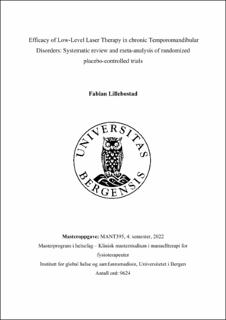| dc.contributor.author | Lillebostad, Fabian Gudmundsen | |
| dc.date.accessioned | 2023-01-24T03:27:12Z | |
| dc.date.available | 2023-01-24T03:27:12Z | |
| dc.date.issued | 2022-11-18 | |
| dc.date.submitted | 2023-01-23T09:30:48Z | |
| dc.identifier.uri | https://hdl.handle.net/11250/3045579 | |
| dc.description.abstract | Hensikt: Temporomandibulær dysfunksjon (TMD) rapporteres med tilsvarende prevalens som fibromyalgi, korsryggsmerter og migrene. Inflammasjon spiller en viktig rolle i patogenesen og opprettholdelsen av sykdommen. Low-level laser therapy (LLLT) anbefales ikke i anerkjente kliniske retningslinjer for behandling av TMD. Jeg undersøkte effekten av LLLT på TMD for selvrapportert smerte, og betydningen av et dose-respons-forhold for behandlingseffekt. Studiedesign: Systematisk oversikt med metaanalyse. Materiale og metode: Relevante artikler ble identifisert gjennom søk i PubMed og Embase 3. juni 2022. Jeg begrenset søket til de 10 nyeste publiserte studiene rapportert på engelsk eller nordisk språk. Kun randomiserte, placebokontrollerte studier (RCT) av deltakere med kronisk TMD – behandlet for smerte med LLLT påført enten temporomandibulærleddet eller kjevemuskulatur – ble inkludert. Det ble utført en random-effects metaanalyse av alle inkluderte studier. Studiene ble subgruppert etter etterlevelse til doseanbefalingene fra World Association for Laser Therapy (WALT). Resultater: 10 RCTer (N = 423) ble inkludert i denne systematiske oversikten og metaanalysen, to med anbefalte doser og åtte med ikke-anbefalte doser. Hovedfunnene viste større smertereduksjon av laser sammenliknet med placebo umiddelbart etter siste behandling, men forskjellen kun grenset til statistisk signifikans (SMD = -0.63 (95%CI -1.26 to 0.01), I2 = 85%, n = 338). Ved oppfølgingstidspunkt 1-8 uker etter gjennomført behandling gav LLLT en høyst signifikant bedring sammenliknet med placebo (SMD = -1.51 (95% CI -2.56 to -0.47), I2 = 92%, n = 279). Resultatene fra subgruppeanalysen av anbefalte doser viste at LLLT reduserte smerte i større grad enn placebo, dog ikke signifikant (SMD = -4.05 (95% CI -11.22 to 3.13) I2 = 97%, n = 44). Det samme gjaldt for de ikke-anbefalte dosene (SMD = -0.39 (95% CI -0.86 to 0.08) I2 = 73%, n = 336). Konklusjon: Resultatene indikerer at LLLT kan redusere TMDsmerter. Den statistiske heterogeniteten var høy, men var forårsaket av én enkelt, mindre studie. Flere studier med anbefalte doser fra WALT behøves i kartleggingen av et dose-respons-forhold. Prospero-protokoll: Vedlegg. Nøkkelord: TMD, temporomandibulær dysfunksjon, orofacial smerte, LLLT, lavenergi medisinsk laser, systematisk oversikt, metaanalyse | |
| dc.description.abstract | Objectives: Temporomandibular disorders (TMD) are perhaps as prevalent as low back pain, fibromyalgia, and migraine. Inflammation has shown to play a key role in the pathogenesis of TMD. Low-level laser therapy (LLLT) is generally not recommended in clinical guidelines for TMD. I investigated the effectiveness of LLLT in TMD and whether a dose-response relationship exists. Design: Systematic review and meta-analysis. Data sources: Eligible studies were identified through PubMed and Embase on 3 June 2022. The search was restricted to maximum 10 of the most recently published studies reported in English/Nordic language. Eligibility criteria for selecting studies: Only randomized placebo-controlled trials (RCT) involving participants with chronic TMD who had their temporomandibular joint and/or masticatory muscles irradiated by LLLT were included. Data extraction and synthesis: A random effects meta-analysis of self-reported pain was performed. The trials were subgrouped in adherence to the World Association for Laser Therapy (WALT)´s treatment recommendations. Results: 10 RCTs (n = 423) were included in this review and meta-analysis, two with recommended doses and eight with non-recommended doses. The overall pain result immediately after completed therapy favored LLLT over placebo, but the difference was only borderline significant (SMD = -0.63 (95%CI -1.26 to 0.01), I2 = 85%, n = 338). The overall follow-up pain result 1-8 weeks after completed therapy highly significantly favored LLLT over placebo (SMD = -1.51 (95% CI -2.56 to -0.47), I2 = 92%, n = 279). The pain results of the subgroup analysis of recommended laser doses favored LLLT over placebo, but not significantly (SMD = -4.05 (95% CI -11.22 to 3.13) I2 = 97%, n = 44). The same applied to the non-recommended laser doses (SMD = -0.39 (95% CI -0.86 to 0.08) I2 = 73%, n = 336). Conclusion: The results indicate that LLLT can reduce TMD pain. The statistical heterogeneity was high, but it was caused by a single trial with a moderate sample size. More trials with WALT´s recommended doses are needed in the search for a possible dose-response relationship. Prospero protocol: Supplementary material. Keywords: TMD, temporomandibular disorder, orofacial pain, LLLT, low-level laser therapy, systematic review, meta-analysis | |
| dc.language.iso | nob | |
| dc.publisher | The University of Bergen | |
| dc.rights | Copyright the Author. All rights reserved | |
| dc.subject | metaanalyse | |
| dc.subject | systematisk oversikt | |
| dc.subject | lavenergi medisinsk laser | |
| dc.subject | temporomandibulær dysfunksjon | |
| dc.subject | orofacial smerte | |
| dc.subject | LLLT | |
| dc.subject | TMD | |
| dc.title | Efficacy of Low-Level Laser Therapy in chronic Temporomandibular Disorders: Systematic review and meta-analysis of randomized placebo-controlled trials | |
| dc.title.alternative | Efficacy of Low-Level Laser Therapy in chronic Temporomandibular Disorders: Systematic review and meta-analysis of randomized placebo-controlled trials | |
| dc.type | Master thesis | |
| dc.date.updated | 2023-01-23T09:30:48Z | |
| dc.rights.holder | Copyright the Author. All rights reserved | |
| dc.description.degree | Masteroppgave i manuellterapi | |
| dc.description.localcode | MANT395 | |
| dc.description.localcode | MAMD-MANT | |
| dc.subject.nus | 761901 | |
| fs.subjectcode | MANT395 | |
| fs.unitcode | 13-26-0 | |
